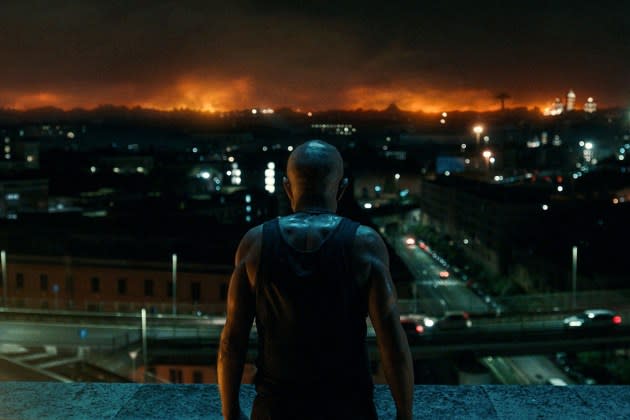‘Adagio’ Review: Gritty Italian Crime Epic Pulls You in Without Knocking You Dead

Adagio, as many musicians know, means “slowly” in Italian. That seems to be one of the guiding principles in this epic slow-burn crime thriller from director Stefano Sollima, who’s known for helming the lauded TV series Gomorrah and ZeroZeroZero, as well as taking on Hollywood jobs like the actioners Without Remorse and Sicario: Day of the Soldado.
He certainly has style to boot, and this very Heat-like story, which takes place in parts of Rome rarely seen in mainstream movies, is loaded with ambience, as well as brawny performances by a triumvirate of Italy’s best working actors: Pierfrancesco Favino, Toni Servillo and Valerio Mastandrea. What it lacks, however, is a gripping and original plot, as well as enough dazzling set pieces to make all the late exposition worthwhile.
More from The Hollywood Reporter
'AGGRO DR1FT' Review: Travis Scott in Harmony Korine's Trippy, Experimental Assassin Flick
'The Palace' Review: Roman Polanski's Dreadful Ensemble Comedy Attempts to Eat the Rich
Premiering in competition in Venice, Adagio will likely be a local hit, with Sollima delivering the kind of Michael Mann-style cops-and-robbers drama that Italians rarely get on the big screen. It’s harder to see the movie making much of a splash overseas, although the quality of the direction could get Sollima some more work shooting bigger things abroad.
It takes a while for the story, written by Sollima and regular co-scribe Stefano Bises, to kick into high gear — a gun isn’t drawn in Adagio until the 30-minute mark — and for much of the film’s first hour we spend time getting to know its main characters: There’s the teenage hip-hop head, Manuel (Gianmarco Franchini), who lives with his senile dad, Daytona (Servilo), and has been tasked with a dangerous undercover mission by the thuggish Polniuman (Mastandrea). And then there’s Cammello (Favino), a former thug who’s at the end of his tether when he gets tangled in everyone’s mess.
Sollima doesn’t initially reveal how these four guys are related, slowing down the action at various points in the second act to finally explain things. Withholding information seems to be a key tactic: For instance, we don’t realize Polniuman is a cop — albeit a very crooked one — until we’ve already seen him doing a bunch of bad things. Likewise, the imposing Cammello’s past and present tragedies only come into focus after some time.
This type of plotting offers certain rewards late in the game, but also makes it difficult to fully invest in Adagio from the get-go. Likewise, the well-realized opening sequence, during which a massive wildfire engulfs the hills around Rome while Manuel infiltrates a nightclub to spy on a man dressed in drag, is filled with plenty of compelling atmosphere but doesn’t exactly grip you in your seat.
Sollima, working again with DP Paolo Carnera, does deliver the goods in the third act, especially during a finale set in Rome’s Termini station while crowds flee the city on fire and blackouts keep cutting the lights off. The director has a knack for staging gritty, realistic action, whether in that scene or in the rundown apartments where ex-gangsters like Daytona and Cammello waste away in the heat. (If crime is supposed to pay, these guys should ask for a raise.)
Very much like in Heat, Sollima builds up to a big showdown between those latter two characters in the middle of the movie, with Favino and Servillo taking over for Pacino and De Niro. It’s hard to say who does it better, the Italians or the Italian-Americans: The first two are formidable actors, having starred in some of the better local films of the past two decades (among them The Great Beauty, Il Divo, The Traitor and Romanzo Criminale). At the same time, Adagio just doesn’t have the narrative momentum that Mann’s movie had, so the strong performances get undercut by a weaker pulse.
The film does, however, work its way to a satisfying if somewhat foreseeable ending where everyone gets what they deserve, including the morally bankrupt Polniuman. Sollima broke onto the scene back in 2012 with the police drama A.C.A.B. — All Cops Are Bastards, and that title definitely seems to be the underlying theme in Adagio, where it’s hard to tell for a while who’s a cop and who’s a crook, and where bad men pay for their sins in one way or another. (Women are nearly absent from this movie.)
Another plus is the use of Roman locations that are far from the tourist spots we’re familiar with — and which were exploited to a max in Mission: Impossible — Dead Reckoning and Fast X, two summer blockbusters that featured nearly identical car chases through the center of town. Here, Sollima gives us the ugly underside of the city, which is something of a specialty of his if you’ve seen his TV work. Those places ultimately feel as pertinent to the story as the characters themselves, broken down and doomed to fail.
Best of The Hollywood Reporter

 Yahoo News
Yahoo News 